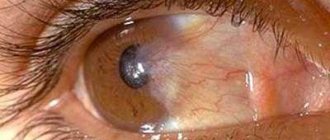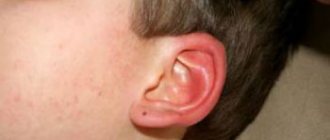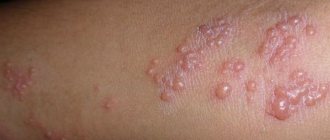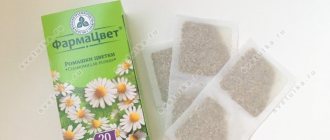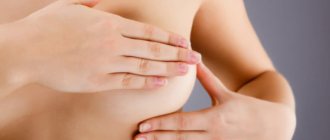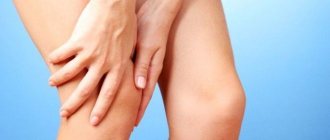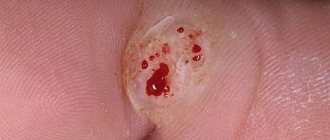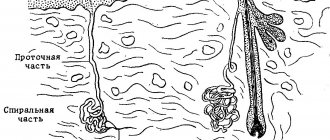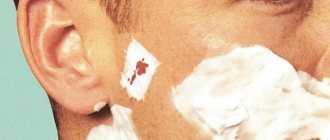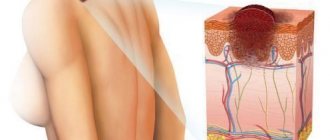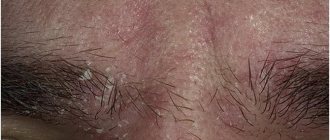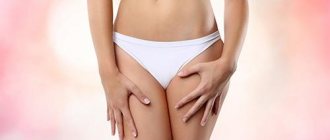Causes of dermatitis
The reasons for the formation of varicose dermatitis on the legs include:
- Poor circulation in the lower extremities, namely: blood stagnation;
- Phlebeurysm;
- Thin walls of blood vessels;
- Genetic inheritance and predisposition to this disease;
- Vessel thrombosis of the legs;
- Diabetes;
- The presence of infectious diseases;
- Injury to the legs with damage to the veins.
Varicose dermatitis develops due to vascular thrombosis due to varicose veins. This process affects the lower limb, since as a result of upright walking, the valve system of the lower limbs has undergone significant overload. The load on the legs causes complications in the outflow of the feet and the development of blood stagnation.
However, there is a muscular frame in the legs that helps pump blood to the heart while walking. Therefore, people who do not lead an active lifestyle and are obese are more likely to develop varicose veins - their valves do not receive muscle help.
In addition, the likelihood of developing varicose veins increases due to blood thickening due to chronic dehydration or taking medications. Thus, oral contraceptives increase the risk of varicose veins.
However, varicose dermatitis does not appear immediately, but with the progression of vein expansion. As a result of impaired blood outflow from the extremities and the development of edema, the skin does not receive oxygen saturation, and destruction processes begin in it. If this process is not treated early, there is a risk of complications developing, such as:
- trophic ulcers;
- microbial eczema;
- gangrene of the limb;
- sepsis.
If left untreated, the affected limb will need to be amputated to prevent blood poisoning and death.
The causes of varicose dermatitis, as mentioned above, are venous diseases, namely:
- varicose veins;
- venous thrombosis of blood vessels of the superficial or deep system, which may be accompanied by signs of inflammation (thrombophlebitis).
The lower extremities are an ideal place for blood stagnation. The main factor contributing to this is the force of gravity. In order for blood to circulate normally, the excellent condition of not only the heart, but also the arteries, capillaries and veins is necessary.
During stagnation, blood forms a kind of depot in the veins. To return blood to the general circulation, the muscles of the vein wall are used. This layer of muscles is quite strong, and there are also valves along the flow, as a result of which the blood moves, overcoming the force of gravity, and moves upward.
The work of the lower leg muscles and negative pressure in the chest also play an important role in normal blood circulation. If the functioning of at least one of these organs is disrupted, blood stagnation occurs.
In the presence of all this, it is increasingly difficult to overcome the force of gravity, and the muscular wall of the veins is subject to dystrophy.
In addition, the process of weakening the muscles that help blood move upward is greatly facilitated by the relatively small volume of muscle fibers.
In addition to all this, the muscle wall decreases due to factors such as:
- diabetes;
- smoking;
- drinking alcohol too often.
In the upper extremities, such problems do not exist, since there cannot be varicose veins there, and therefore there cannot be varicose dermatitis.
Thrombosis can also be there, but it develops for other reasons, including:
- pathologies of the mammary glands (this is typical only for women); therapeutic manipulations carried out in this area.
However, thrombosis in the case of the upper extremities cannot lead to venous dermatitis. Stagnant blood has a significantly increased viscosity, resulting in the formation of blood clots. This is aggravated by taking contraceptive drugs, frequent abortions and pregnancies.
In conditions of increased blood viscosity, the body makes attempts to return it to the bloodstream. To achieve this, the permeability of the venous walls increases, and the liquid component of the blood enters the interstitial space. This is how swelling is formed. This edematous fluid, in turn, inflames the skin, resulting in varicose dermatitis of the legs.
It is worth noting that the disease is equally common among both sexes, however, children do not suffer from it, even if they have varicose veins.
Before looking for ways to solve the problem, it is important to visit a doctor and determine the causes of the development of varicose dermatitis. Among adult patients with varicose veins, almost a third suffer from this type of dermatitis.
The root cause of this is a lack of tissue nutrition due to impaired blood circulation. Insufficiency of valves in the blood vessels, improper distribution of blood, the skin becomes thinner and dry.
This disease mainly affects older people. It is often diagnosed in women.
Typically, illness of the lower extremities is associated with improper nutrition of the skin of the leg. Insufficient blood flow can develop due to malfunction of the valves of varicose veins, and because of this, the skin begins to dry out and itch.
Excess weight and varicose veins increase the likelihood of developing varicose dermatitis.
The most common causes of stasis dermatitis include the following pathologies:
- Phlebeurysm.
- Chronic venous insufficiency.
- Thrombosis of superficial and deep veins.
- Endocrine diseases (diabetes mellitus).
- Leg injuries in which veins were damaged.
- Infectious diseases.
Symptoms and causes of the disease
During its development, the disease goes through several stages, and at each of them the symptoms become more severe.
- The onset of the disease is characterized by a regularly occurring feeling of heaviness in the legs. It is accompanied by mild swelling of the lower extremities at the end of the day.
- As the disease progresses, pain in various parts of the legs increases after physical activity, a network of capillary vessels appears on the surface of the skin of the lower extremities, and large veins become visible.
- At the next stage, swelling of the subcutaneous tissue increases, and the limb becomes bluish in color. The skin tissues become denser, itching develops, and severe pain appears.
- Next, local areas with pronounced pigmentation appear in the form of flaky brown spots, which may be adjacent to pale skin. Sensitivity in the limbs is impaired, and convulsions may occur. In different parts of the legs, skin separation occurs, bubbles filled with light-colored liquid appear, and crusts form.
- The subsequent stage of the disease is accompanied by the formation of venous ulcers, which are formidable symptoms of the resulting venous insufficiency in its chronic form. Ulcers can be single or multiple.
If the disease is advanced, they can develop to enormous sizes. If they become infected, they begin to fester and cause intoxication of the body.
Experts say that even initial symptoms are a reason to consult a doctor and begin treatment for a developing disease.
There are several main reasons that result in the development of varicose, or stagnant, dermatitis:
- hereditary predisposition;
- bad ecology;
- high levels of stress;
- allergic reaction to latex and rubber.
Depending on the cause that caused the development of dermatitis, it can be divided into;
- Irritable;
- Allergic.
Signs of stasis dermatitis can appear not only in the legs, but also on the face, neck, and groin. Areas of dried out epidermis form on the face, and the patient suffers from unbearable itching in the tissues affected by the disease. The skin around the lips turns pale, and additional dry and flaky folds form on the eyelids. Crusts and scaly rashes appear on the neck, as well as on the face. The patient scratches the affected areas, contributing to their infection.
Clinical picture
- Itching - dry skin flakes, itching worsens mainly at night. The skin turns red and slight swelling may be noticeable. Over time, this part of the skin begins to secrete fluid and turn brown.
- Skin ulcers - during this period the patient notices a lack of appetite, general weakness and irritable behavior.
- Development of trophic ulcers - skin pigmentation first appears, after which the spots transform into ulcers.
In addition, based on the clinical picture, specialists can determine the stage of development of varicose dermatitis. For example, the first stage is characterized by small petechiae, as well as fusion of dermatitis areas, peeling of the skin, and itching. The second stage is manifested by increased pigmentation due to the transformation of hemoglobin. Under the ankles, the skin becomes atrophic.
Causes of skin disorder on the legs
When the blood flow in the tissues and skin of the legs is disrupted, then there is a lack of oxygen and other vital microelements of the cells, and the functioning of their valves becomes difficult. Because of this, not only blockages of the venous arteries occur, but also difficult blood circulation through the vessels and capillaries.
Before looking for an answer to the question of how to treat varicose dermatitis of the lower extremities, you should first understand all possible preconditions that can become provocative even in addition to the main cause - varicose veins or inflammation of the veins.
A skin disorder on the legs can occur due to the following factors:
- blockage of veins, vascular thrombosis, or their dilation (as the main type of provocative disease);
- venous insufficiency at the chronic stage;
- overweight;
- unhealthy diet;
- sedentary lifestyle;
- impaired metabolism;
- diabetes mellitus
In addition to the main diseases or factors that can harm the health of the feet, dermatitis can also form due to frequent damage to the integrity of the skin. When a person frequently gets injured, bumps, wounds, cracks, even open formations due to allergies and other similar issues appear on the skin. Any violation of the protective layer (epidermis) leads to infection and the development of dermatitis.
Treatment in the first stage
The development of varicose dermatitis occurs in two ways: progressive with a fast-flowing scenario of the disease and chronic, long-term period.
Treatment is carried out immediately after determining the severity. A good doctor will determine the level of complexity of the underlying disease and select a comprehensive treatment, which will consist not only of medications, but also other methods of therapy.
The first step in treatment should be lifestyle changes. Physical therapy is indicated for all patients. Often it consists of morning exercises for 20 minutes after waking up. This is necessary so that the blood that has stagnated overnight begins to circulate throughout the body again.
Description of the disease
First, problems appear with the veins, their wall gradually becomes thinner, and the liquid component of the blood leaks into the covering tissue.
This provokes the appearance of varicose dermatitis. As a result, inflammation occurs, which changes the appearance of the skin, it begins to peel off and itch. This disease has a mostly chronic form; after this, the skin of the lower extremities must constantly be given close attention. If this is not done, trophic ulcers may arise in the future, the treatment of which is difficult and time-consuming.
https://www.youtube.com/watch?v=W_lze_xzS7I
Until such complications manifest themselves, surgery may be required.
Let's figure out why varicose dermatitis occurs.
This disease appears most often due to the following problems with the veins:
- varicose veins;
- venous thrombosis of vessels of the deep or superficial system. In this case, there may be signs of an inflammatory process (thrombophlebitis), or there may not be any.
In the lower extremities, blood most often stagnates due to the action of gravity, which is why the prerequisites arise for a kind of blood depot in the veins. But venous vessels have certain characteristics. This is necessary to return blood to the general circulation. The wall of the veins has a strong muscle layer, as well as valves along the flow of blood.
The lower leg muscles and the presence of negative pressure in the chest also contribute to this, as a result, the blood in the vessels rushes upward.
Excess weight, prolonged standing, injuries to the lower extremities, kidney and cardiovascular diseases significantly increase the load on the veins. It becomes more and more difficult for them to overcome the force of gravity, so dystrophy of the muscle wall occurs.
But this is not varicose dermatitis yet.
We looked at how varicose dermatitis (photo was also presented) of the second stage is treated. What to do if the disease worsens?
Causes of varicose dermatitis on the legs in adults
To cure this disease, it is necessary to pay a lot of attention to each factor:
- Improve the outflow of venous blood.
- Eliminate swelling.
- Eliminate the inflammatory process.
- Moisturize the affected skin, which is necessary to prevent the appearance of cracks.
- Prevent the appearance of pus in wounds.
To prevent all of the above from happening, systemic therapy is prescribed, which includes taking pills, giving injections and applying ointments to the surface of the affected skin. It is worth noting that the list of treatments used is specific for each stage of the disease. At the same time, when choosing drugs, the characteristics of the patient’s body are also taken into account.
Treatment at the first stage involves the appointment of the following drugs:
- Medicines based on diosmin, namely Venorus, Phlebodia and Detralex. Taking these drugs improves venous outflow. The active substance increases the tone of the muscles of the venous vessels.
- To eliminate congestion in the veins, special compression garments, tights or stockings are worn, which perform the functions lost by the vessels.
- Itching and other unpleasant sensations are eliminated by antihistamines.
- To prevent the skin from becoming cracked, creams, lotions and ointments are applied to it, which moisturize the skin, giving it elasticity and firmness; you can also additionally lubricate the skin with protective agents.
Psoriasis can be cured by anyone at home. You will forget about the disease, stable remission for many years! There is a cream that can regenerate the skin and heal it from psoriasis.
What does varicose dermatitis look like?
At the beginning, the patient does not have any signs of skin lesions, but a stagnant process gradually develops in the area of the dorsum of the feet and ankles of the legs. Sometimes in the evenings there is pain and heaviness in the feet, swelling appears. Visible spider veins, or telangiectasias, then appear. Typically, it may take several months to several years for these signs to appear. At this stage, a small percentage of people who care about their health usually try to examine and treat manifestations of varicose veins and do not expect more serious complications.
Dermatitis is a sign of an advanced disease, and usually it precedes the formation of a trophic ulcer, due to severe circulatory disorders in the legs. Its symptoms are as follows:
- against the background of normal pain and heaviness in the legs, more often – pronounced swelling appears in the area of the ankle and ankle joint;
- then cyanosis of the skin occurs and tissue compaction occurs;
- itching and nagging pain occur;
- then peeling and thinning of the skin on the legs occurs, which indicates a violation of tissue trophism. Nails become dull, hair falls out, the skin of the foot may be cold to the touch;
- at the next stage, the formation of an ulcer actually begins. Dermatitis becomes destructive: blisters and crusts appear. These symptoms tend to spread, and the tissues tend to become infected, which sharply increases the risk of septic complications due to a sharp decrease in immunity in the affected tissues due to chronic ischemia.
Treatment of varicose veins at the stage of congestive dermatitis is a complex task and must be comprehensive. Since surgical intervention is already contraindicated in the formation of ulcers on the legs, it can be performed at the stage of incipient skin changes. But we will list the basic principles of conservative treatment of this disease.
Signs of venous dermatitis
The disease varicose dermatitis of the lower extremities has its own specific symptomatic signs, the manifestation of which depends on the characteristics of the patient’s body. The skin of the lower extremities is primarily affected by the disease.
The appearance changes due to the presence of an inflammatory process and a change in the color of the epidermis (it becomes red-violet and hot to the touch). The process of suppuration on the extremities in most cases can be accompanied by intense itching, which practically does not stop its activity.
Swelling of the extremities during the disease is quite severe, which can often affect the difficulty of motor activity of the lower extremities. So-called blisters very often appear on the skin, which can subsequently open and develop into a crust.
Due to such disorders, the skin of the extremities acquires a rough structure, begins to peel off and form brownish spots.
The advanced form of the disease progresses to the chronic stage, which is characterized by the presence of ulcers and necrosis.
Symptoms of varicose dermatitis develop gradually and include:
- change in skin color;
- thinning of the skin;
- itching;
- peeling, appearance of vesicles;
- trophic disorders;
- secondary infection.
Symptoms and diagnosis of the disease
- the skin becomes rough and dense. There are areas that peel and become covered with brown spots;
- the skin on the legs becomes inflamed, their temperature rises significantly and the color changes to red-violet;
- bubbles form, which after opening form crusts;
- if the malaise is started, it can go into a chronic stage, areas with necrosis and ulcers form;
- there is often swelling, and significant swelling;
- inflammation is complemented by continuous itching;
- Weeping areas appear on the skin.
Symptoms and their intensity also directly depend on the stage of varicose dermatitis:
- First stage. At this stage, the areas around the vessels that are affected by varicose veins become inflamed. There is itching, small petechiae and scaly dermatitis.
- Second phase. Brown pigmentation and atrophic epidermis are symptoms of this stage.
- Third stage. The most difficult stage is characterized by acute inflammation and the presence of a trophic ulcer.
Symptoms
Varicose dermatitis received a second “folk” name – “venous eczema”. The essence of the disease lies in negative metamorphoses occurring in the valve apparatus of the vein and the walls of blood vessels.
The disease can be classified into several stages according to its manifestations and severity. Treatment carried out in the first stage is considered the most effective.
Dilation and thrombosis of the veins of the lower extremities develop in several stages. Accordingly, each of them will exhibit different symptoms of varicose dermatitis.
The manifestations of varicose dermatitis are individual for different patients, but there are a number of common signs, and first of all these are changes in the skin of the legs.
Varicose dermatitis of the lower extremities has several stages of progression. It is very important to begin treating the disease before the condition of the veins completely deteriorates and it becomes impossible to do anything without surgical intervention.
The first stage of the disease manifests itself:
- periodic itching;
- pronounced redness of the area of the skin where problems with blood vessels are observed;
- changes in the appearance of the skin;
- the appearance of a blistering rash.
The first stage is characterized by a slight change in the skin, and one can observe a shine appearing on the tissue and its inflammation. The itching is not very disturbing and appears periodically.
The second stage is characterized by the appearance of severe itching, the formation of a large amount of blistering rash, a change in the appearance of the skin, and the formation of painful nodules under the tissue. In the second stage, the itching takes on a permanent form, the localization of the rash increases, which not only does not go away on its own, but also begins to open.
The density of the skin increases, its pigment is saturated, peeling and crusts may appear on it. Often nodules can be felt under the skin.
How does dermatitis develop?
Boil causes, symptoms, diagnosis, treatment
On the lower extremities, the veins are the largest and have a powerful muscle wall. This is especially true for deep-lying vessels. In case of any venous diseases, the vascular wall is the first to suffer. This leads to the appearance of protrusions under the skin - varicose veins. The skin begins to stretch and thin.
In addition, skin nutrition is disrupted. It becomes dry, very sensitive to irritants, and easily damaged. Since the muscles of the vascular wall change their structure, blood cannot flow freely through the veins. She begins to stagnate in them.
As a result of blood stagnation, its liquid part (plasma) begins to leak through the wall. Swelling forms under the skin, and sometimes even blood cells can come out, forming hematomas. As a result, stagnant dermatitis develops.
Since the venous wall has great compensatory capabilities, the disease can be asymptomatic for a long time. However, if there were already skin diseases or the vascular wall was initially damaged, dermatitis develops quite quickly.
Initially, the physiological state of the skin changes. It becomes excessively dry, its upper layer, the epidermis, becomes thinner. Epidermal cells begin to die much faster than in a healthy person. As a result, peeling appears on the skin. The skin takes on a bluish color. This condition can last for several years. The patient is concerned about severe itching of the skin, which appears as a result of irritation of the nerve endings of the skin. Damages and bruises constantly appear on the skin.
Then a disturbance in the nutrition and innervation of the skin occurs - trophic ulcers develop. These are areas of dying skin that are no longer able to recover. The ulcer spreads both in width and depth. Not only the skin, but also the muscle layer can be damaged. Such ulcers heal very poorly. Weeping is constantly observed, bleeding from ulcers and discharge of pus are possible.
If left untreated, this condition can develop into purulent complications - phlegmon or gangrene of the lower limb. Some diseases and conditions of the body contribute to the occurrence of complications:
- excessive use of nicotine and alcohol;
- diabetes;
- obesity;
- pathology of the adrenal glands.
Treatment
In order for the treatment to be effective, it is necessary to treat the underlying disease – varicose veins. The first step in this is to eliminate blood stagnation in the venous bed.
Raising your legs up while resting and sleeping helps relieve swelling. This is done due to the passive outflow of blood through the vessels and valve apparatus. This should be repeated as often as possible - for example, when working sedentarily, you should take a similar rest for your legs every hour. At night, you need to constantly support your limbs in this position with the help of a bolster or pillows.
Walking has a beneficial effect on the condition of vein valves. Training the muscles of the lower leg can promote better outflow of venous blood due to the muscle pump.
To make therapy more effective, doctors recommend reducing excess weight, since obesity contributes to the formation of blood clots in the venous system.
In addition, you can use alternative medicine. Hirudotherapy is a method known since ancient times and is used very often in modern medicine. Heparin and hirudin, which are contained in the glands of the leech, prevent the formation of blood clots, affecting the coagulation factors in the blood. This prevents platelets from sticking together and prevents the formation of clots.
However, this procedure can only be performed in medical institutions under the supervision of an experienced specialist.
Treatment of varicose dermatitis is carried out at the second stage of the disease of varicose veins, because without treatment the causes of ointments and tablets are powerless. To do this, it is necessary to remove the affected vein. Methods for such operations may vary.
The classic method is to remove the vein using open surgery under general anesthesia. This is used only for a large area of damage and the presence of secondary complications - trophic ulcers, gangrene or pyoderma.
During such operations, several incisions are made in the skin and the vein is pulled out piece by piece. This method is very traumatic, since it is characterized by the formation of extensive hematomas, which can be complicated by infection and fester.
In modern medicine, the method of laser removal of varicose veins is more common. It consists of endovascular coagulation of the dilated vein. There are practically no scars or incisions left after such an intervention, only small dots on the skin.
To treat trophic ulcers, it is necessary to excise the lesion site, followed by drainage and rinsing for better healing.
If the process is advanced, amputation of the limb followed by prosthetics may be required.
Varicose dermatitis responds well to treatment with folk remedies only in the early stages. Different methods help with many symptoms, so it is worth choosing the treatment method individually.
Severe swelling of the legs can be relieved with a tincture made from chestnuts. To do this you will need chestnut fruits and ethyl alcohol.
100 grams of plant material are required, and about a liter of alcohol base. Chestnuts need to be crushed in a meat grinder or blender, then poured with alcohol and placed in a dark place for about a week, stirring occasionally.
You need to take the product 6-8 drops diluted in 100 milliliters of water before breakfast.
Treatment of varicose dermatitis is long and complex. It requires a lot of patience from the patient. Moreover, if you do not start treating varicose veins of the lower extremities themselves, then treating varicose dermatitis is a pointless exercise.
For the treatment and prevention of varicose veins of the upper and lower extremities, our readers successfully use the new method of E. Malysheva. Having carefully studied this method, we decided to bring it to your attention.
non-drug treatment methods:
- hirudotherapy;
- physiotherapy;
- water procedures;
- herbal medicine;
- wearing medical compression garments.
- moisturizing and nourishing the skin;
- treatment with steroid ointments;
- wearing compression garments;
- surgical treatment;
- gradient vacuum therapy.
Good day, dear readers! The following article will help you understand the issue of treating varicose dermatitis with medications and folk remedies. As you know, vascular diseases are in first place in terms of prevalence, so you can often find complications associated with impaired blood flow.
These are dermatitis, trophic ulcers, disruption of innervation, sensitivity, changes in the skin and much more.
Vascular disease is primary, but entails unpleasant and rather difficult complications in terms of treatment. Today I will talk specifically about dermatitis, which is called varicose dermatitis.
Treatment of dermatitis will not bring results if you do not pay attention to the underlying disease. Let's look at how vascular diseases of the lower extremities are treated. To receive adequate therapy, you need to approach it comprehensively, so your treatment will be handled by a vascular surgeon and a dermatologist. Only after eliminating vascular insufficiency can therapy for varicose eczema begin.
Before the doctor determines how to treat leg dermatitis due to varicose veins, a visual examination and medical history must be performed. Next, therapy methods are selected that allow you to establish blood flow in the affected area, soften and nourish the skin, and also relieve swelling and inflammation. Modern medical science offers the following methods of treating varicose dermatitis:
So, in order to nourish and moisturize the skin, doctors prescribe special ointments and creams that contain the necessary substances and vitamin E. In addition, there is a special hardware effect that reduces the outflow of water from the skin layer, promotes the formation of a protective film on the skin for the purpose of protection from infections and bacterial contamination.
Steroid ointments are not prescribed to all patients, since hormonal drugs can cause side effects. Correct use of such drugs quickly relieves all symptoms of dermatitis (itching, swelling, redness, peeling, ulcers), and also suppresses the inflammatory process.
Compression hosiery is a universal and harmless method of treating varicose veins and its complications. Its compression properties help normalize microcirculation through proper pressure on the lower limbs. You need to take off your underwear only during sleep and hygiene procedures. Only a medical specialist can select the optimal compression level.
Surgical treatment is prescribed to those patients who suffer from the last stage of varicose dermatitis, and conservative methods have not proven effective. Before the operation, the doctor performs an ultrasound examination to clarify the diagnosis and extent of dermatitis.
Gradient vacuum therapy refers to indirect methods of treating varicose dermatitis, but is in great demand today. Using a vacuum effect on the affected areas of the skin, blood flow accelerates, the optimal movement of lymph is normalized, and swelling, which is characteristic of varicose veins and dermatitis, is eliminated.
Only after examination by a doctor and consultation on how appropriate it is to treat varicose dermatitis with folk remedies can you begin treatment at home. There are many unconventional methods to combat this disease, but doctors recommend hirudotherapy and herbal medicine.
- Hirudotherapy is a treatment method that has existed since ancient times, involving the use of medicinal leeches. Their saliva secretes a special enzyme - hirudin, which has an anti-inflammatory and bactericidal effect, and also relieves pain. Regular treatments improve venous and lymphatic drainage.
- Herbal medicine recipes have a complex effect on the entire circulatory and vascular system. Experts approve the following recipes:
- tincture of nutmeg to relieve symptoms of thrombosis;
- tincture on horse chestnut fruits to relieve the inflammatory process;
- night compresses from cabbage leaves to eliminate itching, redness, and inflammation;
- foot baths made of chamomile, nettle, calendula, lemon balm, oak bark, etc.
To eliminate excessive dry skin, you can use herbs along with vegetable oils. Among animal oils, emu oil is considered the most valuable. In combination with traditional medicine recipes, it is important to adhere to a diet, as well as increase the level of activity and mobility.
If there is no treatment for the underlying disease, then treatment for dermatitis will not be effective. In order for the skin to be in order and the disease to be curable, it is worth stabilizing the functioning of the veins in the legs. Therefore, treatment of the disease should be carried out under the supervision of a surgeon and a dermatologist. Eliminated venous insufficiency will be the key to curing dermatitis on the legs.
Treatment of varicose dermatitis will be more effective if started in the early stages. First of all, the cause is determined and treatment of the underlying pathology begins. The goal of therapy is to prevent the progression of the disease, avoid severe complications, and relieve symptoms that cause great discomfort to the patient.
The doctor's task:
- strengthen vascular walls;
- improve venous blood flow in the lower extremities;
- restore lymph outflow;
- heal damaged skin.
For this purpose, a set of measures is being developed, including:
- drug therapy;
- wearing compression stockings;
- treatment with folk remedies;
- if therapy is ineffective - surgical intervention.
In addition, you need to follow the following recommendations:
- Lose weight if you have excess weight.
- Lead an active lifestyle and walk more. While walking, the calf muscles contract, thereby pushing blood upward.
- Include foods containing rutin in your menu. These are chokeberry, buckwheat, sweet pepper and others.
- At every opportunity, try to keep your legs elevated.
- If the skin is constantly inflamed, you need to choose clothes that would not injure the affected areas.
- Shoes should be comfortable, heels no higher than 4 cm.
- Legs affected by varicose dermatitis should not be washed with regular soap. For this purpose, you need to purchase a special detergent without alkali.
Medicines
To treat varicose eczema, drugs of different groups are used. These are tablets and external agents (ointments, gels).
Folk remedies for the treatment of disease are quite popular because they are relatively harmless and effective when used in combination with traditional medicine. Treatment with homemade medications helps well in the early stages of the disease.
You can relieve skin inflammation and reduce swelling using cold aloe compresses, which are cut and applied to the pathological area. The main thing is to take an old plant in which medicinal substances appeared.
Cabbage or grated potatoes must be applied to the site of vascular manifestation regularly, for 1 month. This will help relieve itching and swelling, reduce inflammation, and eliminate damage to the skin. Keep this compress for about 40 minutes, until the used ingredient becomes dry and withered.
Tea tree essential oil will help improve blood circulation. To do this, you need to dilute about 25 drops of oil with 100 ml of water, then moisten a cotton pad in the solution and treat the damaged area on the legs with it.
During treatment, the diet must be enriched with red bell pepper, chokeberry, and buckwheat. These products contain rutin, which strengthens the vascular wall and thereby prevents or eliminates the appearance of varicose veins.
Treatment of varicose dermatitis of the legs is not limited to one effect on the skin. First of all, it is necessary to treat the underlying disease - venous insufficiency, improve blood circulation and microcirculation in tissues, and at the same time eliminate the phenomena of dermatitis.
The complex of treatment for venous dermatitis includes:
- Treatment of varicose veins (vein surgery).
- Drug treatment.
- Diet therapy, body health, exercise therapy.
- Physiotherapy.
- Local impact.
Surgical treatment of varicose veins
This is a prerequisite for curing varicose dermatitis; it often goes away on its own after blood circulation in the legs is restored. The operation involves removing non-functioning veins that create blood stagnation. A timely operation performed by a qualified specialist usually leads to recovery.
Important! You should not be afraid of vein removal surgery, or be afraid of rough scars on your legs. Modern laser technologies leave virtually no marks on the skin.
Diet therapy, body health
Diet is a prerequisite for the treatment of venous dermatitis on the legs. Most often it develops in obese people, so you need to lose weight, limit the caloric content of food, eliminate salt, spices, and alcoholic beverages.
Alcohol, especially beer, is a vascular poison that paralyzes the walls of the veins. It is necessary to change your lifestyle, move more to prevent blood stagnation in the legs.
Special exercise therapy exercises that improve blood circulation in the legs are useful.
Physiotherapy
Ultraviolet irradiation of the legs, infrared and magnetic therapy, laser therapy are prescribed, especially in the presence of trophic ulcers. Mud therapy and hydrotherapy at resorts have a good effect.
Important! The question of how to treat varicose dermatitis is decided jointly by a vascular surgeon (phlebologist) and a dermatologist, and if necessary, other specialists are involved.
Medications
The following medication program is used to treat varicose dermatitis:
- drugs that strengthen the venous wall and increase the tone of the veins (detralex, venoruton, troxevasin, thrombleless, phlebodia);
- medications that thin the blood and improve microcirculation (aspirin, heparin, trental, hesperidin, diosmin);
- drugs against inflammation of the veins (indomethacin, ibuprofen, diclofenac);
- vitamins that strengthen the venous wall and skin cells (ascorutin, aevit, veno-strong, liv-lon and others).
If a bacterial or fungal infection occurs, antibiotics and fungicidal drugs are prescribed, respectively.
External means
There are many products used for external treatment of varicose dermatitis of the lower extremities. The purpose of ointments and gels is to relieve inflammation, improve blood circulation, and stimulate recovery processes in the skin. This group includes:
- ointments heparin, hepatrombin, heparoid, thrombleless - thin the blood, improve microcirculation;
- ointments venoruton, troxevasin, venitan, madecassol and analogues - increase the tone of the venous wall;
- gels actovegin, solcoseryl - stimulate skin restoration processes;
- ointments iruksol, proteox - contain proteolytic enzymes necessary for the treatment of trophic ulcers;
- anti-inflammatory ointments (diclofenac, indomethacin, ketonal, butadione and their other analogues).
If necessary, ointments with antibiotics or fungicides are prescribed if varicose dermatitis is complicated by infection, as well as hormonal ointments with steroids if the process is advanced.
Important! Treatment of varicose dermatitis with ointments is carried out individually only as prescribed by a doctor.
Many pharmaceutical ointments are made on the basis of natural raw materials, just as the treatment of varicose dermatitis with folk remedies is based on medicinal plants. Used: horse chestnut, cabbage and grape leaves, nutmeg, club moss. Tinctures, decoctions and compresses are prepared from these herbs at home.
Horse chestnut tincture
50 g of crushed chestnut fruits are poured with 2 glasses of alcohol, left for 1 week in a place protected from light. Take 10 drops 3 times a day as an anti-inflammatory and blood thinning agent.
Moss moss decoction
Grind the “clubs” of the plant containing the seeds, pour boiling water at the rate of 1 tablespoon of herb to 1 glass of water, boil over low heat for 20 minutes, cool. Take 1 tablespoon 6 times a day to relieve skin inflammation, pain and itching.
Cabbage leaf
Place the sheet in the freezer for several hours, then defrost. Apply to the lower leg at night to relieve redness and itching for 2-3 weeks.
grape leaf
At night, cover the skin with fresh leaves or prepared infusion (half a glass of crushed leaves per 1 liter of boiling water). Has antipruritic and anti-inflammatory effects, stimulates healing.
Important! The choice of traditional medicine for home treatment of varicose dermatitis is best agreed with your doctor.
For varicose dermatitis of the lower extremities, the main thing in treatment is to eliminate the root cause of the disease, and all medications, external remedies, including traditional medicine, must be prescribed by a doctor.
Relieving legs from venous dermatitis using medicinal and folk methods
Venous dermatitis is a disease that occurs against the background of pathological processes in the veins and impaired blood circulation in them. The disease is also called varicose eczema. Appears on the surface of the legs and ankles. This type of dermatitis causes a lot of unpleasant sensations, and in advanced forms, long-term non-healing ulcers may form.
Dermatitis will disappear forever in 3 days! Home method. In order to get rid of dermatitis you need... Interview New treatment Folk recipe netdermatita.ru
We treat DERMATITIS using the new method of Elena Malysheva To cleanse the body and get rid of DERMATITIS you need every day... Elena Malysheva’s website Interview with the doctor malisheva.ru
Treatment of varicose dermatitis is aimed at eliminating the primary disease, as well as relieving symptoms. For this purpose, medicinal methods and traditional medicine are used.
The causes of dermatitis on the legs are:
- phlebeurysm;
- congestion in blood vessels;
- impaired blood circulation;
- hereditary factor;
- cardiovascular diseases;
- increased pressure in the vascular system;
- pregnancy;
- injuries of the lower extremities in which the veins are damaged;
- pathologies of the endocrine system.
It should be noted that most often women after fifty years suffer from venous dermatitis. Excess weight, physical inactivity, poor nutrition, and secondary infections contribute to the development of the disease.
If the disease is not treated, trophic ulcers soon form on the skin of the legs, which grow over time. This condition is dangerous because the ulcers can become infected.
Experts note that this pathology has individual characteristics for each person. But the general symptoms of varicose dermatitis are as follows:
IT IS IMPORTANT TO KNOW! E. Malysheva: DERMATITIS goes away FOREVER! Just need it before bed. Read more—>
- itching, which intensifies in the evening;
- change in color of the skin on the legs (blueness, redness);
- feeling of heaviness in the lower extremities;
- swelling of the legs and ankles;
- peeling of the skin;
- scaly rash;
- pain and fatigue in the legs;
- slow healing of wounds;
- formation of ulcers.
Venous dermatitis must be treated early. Untimely treatment leads to undesirable processes that will take a long time to eliminate.
Therapeutic measures
It is recommended to treat varicose dermatitis in a complex manner, using several therapeutic measures at once. Therapy requires a lot of effort from the patient and a long period of time. All therapeutic measures are aimed at:
- improvement of venous outflow of blood from the lower extremities;
- elimination of swelling and inflammation;
- moisturizing the affected areas of the skin in order to prevent the process of cracking;
- prevention of suppuration of the skin of the extremities.
Each stage of the disease is characterized by the use of specific treatments depending on what symptoms are present. At the initial stage of development of the disease, it is recommended to resort to the use of medications in order to normalize the venous outflow in the extremities.
The most effective drugs in this case are Detralex, Venorus, Varius and Phlebodia. The drugs are available in the form of capsules, the action of which is aimed at increasing muscle tone in the vessels of the veins.
During this period, it is necessary to use special compression garments. The selection should be made together with the treating specialist.
To combat itching in the extremities, you can use Cetrin, Zodak, Varius or Fenistil in the form of an ointment. The use of moisturizing creams is not excluded, especially if the skin has already begun to crack.
The most effective is Seni Care gel. To eliminate blisters on the extremities, a zinc or talc based powder is excellent, and the ready-made mixture can be easily purchased at any pharmacy.
The use of all of the above means makes it possible to get rid of the inflammatory process, reduce the activity of itching, and prevent possible complications of an infectious nature.
Traditional medicine recipes are allowed to be used as an addition to the treatment of the disease.
How to treat varicose dermatitis of the extremities at the second stage of development? In this case, the treatment of the disease is almost the same as that prescribed at the previous stage. Only the treatment for the manifestation of itching changes.
Specialists may prescribe hormonal-based ointments, which must be applied to inflammatory areas of the extremities. These include Elokom, Sinaflan and Lokoid creams.
If suppuration is detected, it is better to use combined agents, for example, ointments with an antiseptic effect (Triderm, Pimafukort). It is possible to take sedatives with a mild effect - Sedasen.
How to treat the final stage of limb disease? Symptoms that appear during this period can be eliminated by using preparatory therapy to begin with in order to eliminate the acute form of the inflammatory process of the disease. Therapy includes:
- compliance with bed rest, while the affected limb should be slightly elevated, this will ensure optimal blood flow;
- washing existing ulcers on the extremities and then removing dead tissue;
- it is important to apply compression through the use of elastic bandages;
- Carrying out careful monitoring of blood sugar levels and, if necessary, restoring it;
- the use of antihistamines in the form of injections.
As for the general rules of care, first of all, increased attention should be paid to the lower extremities. It is important to remember about daily water procedures using soap products. Removing water from the skin of the extremities should be done by soaking the material, after which it is recommended to use moisturizers.
The patient's diet also deserves special attention. It should include foods rich in rutin, for example, bell pepper, rowan or buckwheat porridge.
At the same time, the patient’s body weight should be monitored so that there is no unnecessary strain on the veins. If necessary, it is recommended to consult with an endocrinologist.
Since dermatitis of varicose etymology is considered a chronic disease, the first step is to combat the main problem of the veins, after which the symptoms will begin to disappear. It is for this reason that compliance with preventive measures is important.
As mentioned earlier, as a supplement you can resort to traditional treatment recipes. The most effective include:
- Potato compress. The product is crushed using a grater, after which the mixture is spread on gauze and subsequently on ulcerative formations of the extremities. The compress must be secured on top with material and kept for several hours. The procedure is repeated twice a day for half a month. If desired, you can use a cabbage leaf compress. To do this, the leaves need to be lightly beaten so that they become soft and wrap around the limb.
- Rubbing with birch bud tincture. The main ingredient is poured with vodka in certain proportions, after which it is infused for at least a week. After preparation, it is necessary to lubricate the limbs several times a day.
Therapy methods
Many people who have been diagnosed with this problem are concerned about the question: can the disease be cured? If therapy is started at the initial stage of development, the prognosis is favorable.
In this case you can:
- stop the progression of dermatitis;
- reduce the intensity of clinical manifestations;
- strengthen vascular walls;
- restore the integrity of the skin;
- normalize blood circulation.
You can reduce the intensity of the pain syndrome by normalizing your weight, walking daily, adjusting your diet, resting with your limbs elevated (put a cushion of clothing or a pillow under your feet), and using shoes without heels.
Medication
The doctor will determine how to treat dermatitis. As a rule, drugs from the following groups are prescribed:
- venotonic agents: strengthen vascular walls, eliminate swelling and pain (Phlebodia, Venarus, Troxevasin);
- anti-inflammatory treatment with ointments with the following effect: eliminates inflammation, reduces the risk of thrombosis, normalizes blood flow (Venozol, Ginkor, Liton);
- moisturizers: increase the production of moisture by the epidermis (Panthenol, etc.);
- hormonal drugs: used in severe cases (Advantan, Flucinar);
- wound healing drugs (Solcoseryl, Dermazin);
- antiallergic ointments and tablets (Suprastin, Fenistil, Loratadine);
- drugs with sedative effects (Valerian);
- antibiotics: used for necrosis (Levosin, Levomekol).
Against the background of the main therapy, you can treat with folk remedies, using ointments and rubs made from natural ingredients (Kalanchoe, garlic, horse chestnut, cabbage leaf, etc.).
Operational
If conservative therapy does not bring relief, or severe concomitant pathologies are present (for example, varicose veins, etc.), surgical intervention is prescribed:
- phlebectomy, during which dilated veins are removed;
- stripping, during which a large saphenous vein is removed along with its tributaries;
- sclerosing, which involves gluing the vessel by introducing a substance - sclerosant;
- laser, during which the affected vein is sealed;
- endoscopic, which involves ligating a vein;
- radiofrequency, which involves inserting a radiofrequency catheter into a vein and sealing the vessel.
Possibilities of traditional medicine
- Hirudotherapy. Treatment with leeches is more based on eliminating varicose veins, blood clots, and improving blood rheology;
- A medicine based on horse chestnut will relieve inflammation and swelling;
- Dermatitis is treated with folk remedies taken directly from the garden. For example, a cabbage leaf applied to the site of swelling;
- Club moss can be used as an anti-inflammatory powder.
The use of folk remedies for self-treatment is not recommended without consulting a doctor.
Only a specialist can assess the extent of the lesion and prevent serious complications in time. Stay healthy, follow our news! Bye!
Author of the article: Elena Smirnova (dermatologist)
Drug treatment
Venous dermatitis on the legs requires timely treatment to prevent the development of complications.
The main goal of therapy is to restore lymph and blood flow in the legs, strengthen the walls of blood vessels, and heal wounds:
- Troxevasin
For the treatment of the disease, drugs and ointments are used. In order to strengthen blood vessels, eliminate edema, and relieve pain, venotics are prescribed in the form of tablets: “Detralex”, “Phlebodia”, “Troxevasin”, “Troxerutin” and others. Venorutin, Venozol, and Troxevasin are used as ointments. - To relieve inflammation and prevent the development of thrombosis, as well as normalize blood flow, Hepatothrombin or Venobene are prescribed. It is also important at the initial stage of development of pathology to use moisturizing creams to prevent skin drying, which contain vitamins and panthenol.
- Diclofenac or Voltaren can be used as anti-inflammatory ointments. In severe cases, courses of hormonal treatment are prescribed. Usually the drugs are presented in the form of ointments “Flucinar”, “Advantan”, “Ftorokort”. When ulcers develop, wound healing ointments “Naftaderm” or “Bipanten” are used. Antibacterial drugs may also be prescribed.
- In some cases, antihistamines and sedatives may be required: Suprastin, Zodak, tincture of valerian or hawthorn. Sometimes the doctor prescribes tranquilizers.
Note! For this disease, it is recommended to wear compression stockings to improve lymph drainage.
Symptoms of the disease
Very often the disease affects the lower legs, which is why experts call this disease a skin disorder of the lower extremities. Any vascular congestion can manifest itself in cases where a person moves little and the blood flow in his legs is impaired. Therefore, everyone who leads a more sedentary lifestyle (for example, office workers) should pay attention to the health of their own legs, including, and not just to being overweight or obese.
- Telangiectasia. The formation of “stars” on the skin or vascular “patterns”.
- Reticular varicose veins.
- Dilatation of the main veins (varicose veins).
- Chronic venous insufficiency.
- Trophic varicose veins, which often look like ulcers on the legs. Sometimes this stage is also called a “trophic ulcer.”
First stage:
- sometimes itchy sensation;
- the affected areas of the skin turn red;
- patterns of inflamed vessels and capillaries are clearly visible on the skin;
- sometimes blisters form in areas of inflamed skin.
Second and third stages:
- itching of the skin intensifies;
- there are more bubbles;
- the color and density of the skin change and it takes on an unhealthy appearance;
- nodules can be felt under the skin.
Fourth and fifth stages:
- the skin becomes loose, dry, with continuous spots of redness, covering the entire lower leg, like a sock or leggings;
- bubbles burst in places;
- at the site of burst blisters, skin erosions are formed, turning into ulcers - more expanded erosions.
The most advanced conditions of venous dermatitis on the legs, photos of which should be studied in advance in order to have an idea of what you should not allow the condition of your legs to do, show the absence of skin at the sites of the ulcers. Unprotected places hurt very much, they constantly have to be treated with something and create artificial protection.
Symptoms of varicose dermatitis directly depend on the stage that the patient has. The onset of the pathological process can be detected in the first stages of the disease. But it often happens that characteristic symptoms begin to appear when dermatitis has reached the later stages. Photos of varicose dermatitis of the lower extremities can be found on the Internet.
The basic symptoms of varicose eczema are:
- Redness of the skin, areas of inflammation. The skin in this area is hot on palpation;
- Feelings of itching and continuous burning, heat in the area of the pathological process;
- Edema of soft tissues;
- The presence of characteristic bubbles with liquid contents.
The first stages of the manifestation of the disease are characterized by a slight manifestation of itching on the lower extremities, disturbing a person mainly before bedtime. The skin becomes red in appearance and acquires a shine characteristic of the disease. As the pathology develops, characteristic vesicles (bubbles) with liquid contents begin to appear. Swelling and pain may occur.
Main symptoms of varicose dermatitis
Trophic changes in the veins lead to the fact that itching and burning in a person’s legs become unbearable, characteristic scratching occurs, and a larger number of erosive blisters appear. It is very difficult to cure this type of pathology.
During the process of degenerative changes, the skin becomes denser, acquiring a characteristic cyanotic tint, with areas of peeling, itching and scarring particles. The patient's gait begins to change, the person begins to limp characteristically, trying to reduce the pressure on the affected limb.
Thinning is facilitated by the fact that a small volume of muscle fibers inside is genetically programmed. Also, with diabetes mellitus in smokers and drinkers, degeneration of the muscular wall of the veins occurs faster.
The upper extremities are not subject to this pathological process; varicose veins and dermatitis do not occur in them. Of course, the occurrence of thrombosis cannot be ruled out, but it happens due to medical manipulations in this area, as well as when pathology develops in the mammary glands in women. But there will definitely not be varicose dermatitis of the upper extremities.
Due to the thinning of the venous wall, it is difficult for blood to return to the heart, so it begins to stagnate. It becomes viscous, which leads to thrombosis. If a woman takes combined oral contraceptives, the risk of thrombosis increases. In addition, frequent pregnancies and abortions lead to this.
Despite the viscosity of blood, the body has the task of returning it to the general bloodstream. The permeability of the venous wall increases, which leads to the release of its liquid portion under the skin. This is how swelling in the legs forms. With a large accumulation of edematous fluid, inflammation occurs and, consequently, varicose dermatitis in the lower extremities.
The likelihood of developing the disease is the same for everyone (both men and women), only children are not susceptible to it, even with existing varicose veins.
Stages
Varicose dermatitis has a long-term chronic course, although rapid progression is not excluded. Before the appearance of trophic ulcers, the disease goes through several stages:
- At an early stage, by the end of the day, slight swelling and heaviness in the legs regularly appear.
- Veins begin to protrude on the lower extremities, a red-violet vascular network appears under the skin in the shin area, and pain intensifies in different parts of the legs.
- Swelling of the subcutaneous tissue increases and does not go away well, which is associated with impaired lymph outflow. The skin becomes bluish, denser, dry, itching appears, and pain intensifies.
- Sensitivity in the lower extremities is impaired, and convulsions occur. Areas with pronounced pigmentation, flaky brownish spots, and blisters filled with light liquid appear on the legs, which open and form a weeping surface. In place of the opened and dried blisters, gray-yellow or hemorrhagic crusts appear, after which areas of hyperpigmentation remain.
- At the last stage, single or multiple venous ulcers are formed, which, if left untreated, increase in size and can fester if infected.
Similar article - Get tested for microflora culture
Causes of the occurrence and development of varicose veins in the legs
The most common causes of varicose dermatitis include:
- Venous thrombosis of blood vessels.
- Phlebeurysm.
- Various infectious diseases.
- Leg injuries subsequently damaged veins.
- Chronic venous insufficiency.
- Diabetes
- Diseases of the endocrine system (diabetes mellitus).
And also concomitant diseases in people susceptible to varicose dermatitis are often obesity or atherosclerosis.
People with diabetes are prone to varicose veins
Occupational therapy (leech treatment)
This method has been used since ancient times, and it is used to treat a huge number of diseases. He, like no other, has proven himself well and is still very popular to this day. Leech saliva has healing and disinfecting properties.
In conclusion, I would like to note that treatment should be started prematurely. Dermatitis, like other skin diseases, cannot be cured in one day, but the longer you delay going to the doctor, the more neglected your disease will become. We recommend using traditional medicine in combination with traditional medications, and then you can quickly boast of the end result.
Don't forget about walking, healthy eating, comfortable shoes and comfortable clothes. Do morning exercises and do not refuse feasible loads. All this has a beneficial effect on the vascular system and on the treatment of varicose dermatitis.
